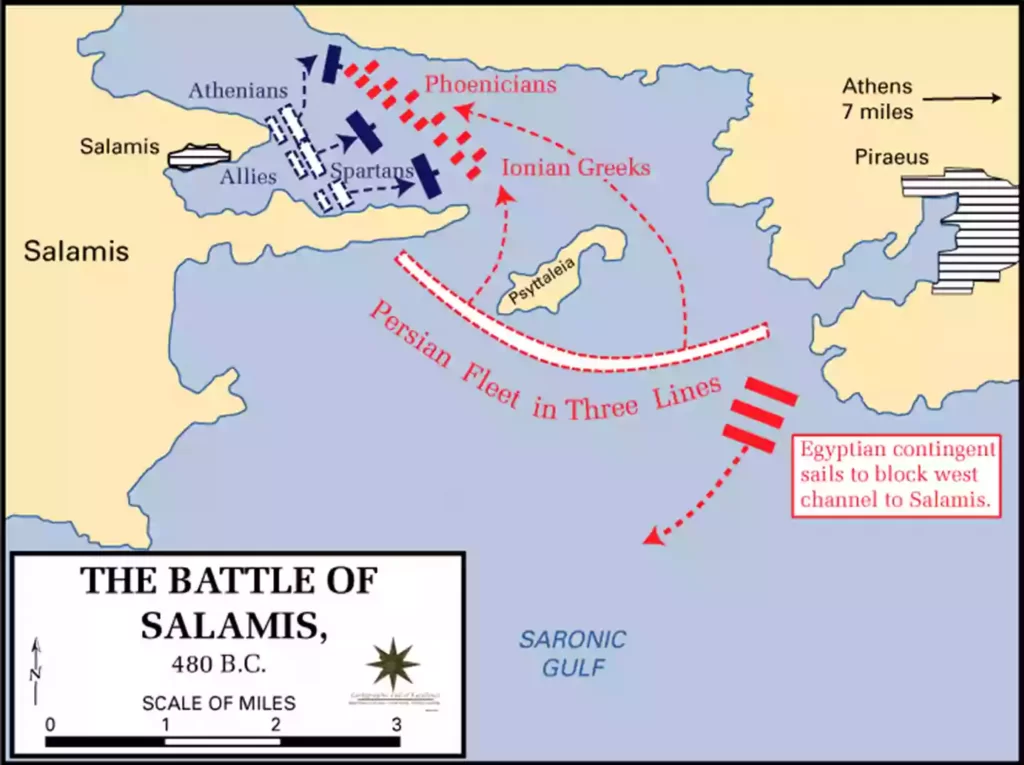Introduction of The Battle of Salamis 480 BC
The Battle of Salamis 480 BC was one of the most important battles in ancient Greek history, due to its immediate and long-lasting consequences. It was fought off the coast of Salamis Island, at Salamis Bay, between an alliance of Greek city-states under Themistocles and an invading Persian army under King Xerxes I in 480 BC. The battle of the salamis resulted in a narrow but decisive victory by the Greeks, due to the actions of Themistocles and the Athenian fleet, which turned the tides of the war against Persia and greatly influenced events in Greece over the next two decades as well as later European history.
Battle of the Salamis 480 BC

In September 480 BC, the Persian king Xerxes captured northern Greece and burned the city of Athens. In addition, he was planning to lead his army by ship in order to take down the Spartans. In the Gulf of Eleusis, the Greek navy, led by the Athenian admiral Themistocles and the Spartan Eurybiades, blocked the narrow straits opposite the island of Salamis, thereby denying Xerxes use of the harbors of Athens. On the night of September 28, the Persian flotilla approached from their encampment at Acarnania, tricked by rumors that the Greeks might flee that had been cunningly circulated by Themistocles. It consisted of about 800 triremes, more than double the Greeks’ numbers.
The strategy of Themistocles made it difficult for the Persians to have the upper hand. As they sailed into the narrow straits, their large number became irrelevant. Seeing the turmoil among the Persian forces, Themistocles leaped at the opportunity, and the Greeks drove hard into the Persian line, their rams sending splinters into the enemy ships or chopping the enemy’s oars to pieces. Following this turn of events, many vessels were captured by Greek marines or sunk, and Xerxes, watching from a promontory above the straits, was horrified and ordered a retreat. His navy now numbered 200 ships shattered and all, he withdrew much of his army to Asia Minor. As a result, the Greek city-states gained valuable breathing space to rebuild their forces and to finally drive the Persians out of Greece.

Triremes Ship
Around 700 BCE, Triremes – ships with three banks of oars on each side – appeared, forming the backbone of Eastern Mediterranean fleets for the following four centuries. Fast and highly maneuverable, Triremes could sail through an opposing line and turn around to attack from the rear. Lots of ships in antiquity were fitted with spikes designed for ramming enemy vessels. In 483 BCE, for example, the discovery of a silver mine near Athens enabled the city to commission a fleet of 200 triremes. despite its strengths, without these ships, it would have struggled to compete against the Persian fleet of triremes.
Which country’s fleet lost the battle of salamis 480 BC?
The battle of salamis was a hard-fought victory for Greece, led by King Leonidas. Of course, Greece wasn’t actually a unified country at that point. Rather, it was just a bunch of city-states squabbling over territory and resources. There’s no real record on how exactly Persian Wars came to be, or why Persians were so desperate to conquer Greece that they kept trying for decades after their initial defeat. Greek legend claims that Persia demanded tribute from Greece and would only accept being paid in gold and silver. When two messengers were sent to deliver payment, they were killed and thus began wars between Persia vs Greece.
The Main Battle – Battle of the Salamis
The Battle of the Salamis was fought in September, 480 B.C., between the Greeks, under Themistocles, and the Persians, led by Xerxes. The Persian army had been laying siege to Athens for a year when a Greek fleet arrived at Salamis. During battle, Themistocles’s advance naval force would collide with the advancing Persian warships and destroy part of the force in order to allow his main body to attack the Persian’s left flank – causing considerable damage to their navy. The outcome would be that Xerxes would flee back to Persia and eventually lose power.
Greco – Persian Wars
Persian Wars is the common term for the several wars between the Achaemenid Persian Empire and Greek city-states that started in 499 BCE, as well as their aftermath, which lasted up to 449 BCE. Although Herodotus’ The Histories -the main source about these wars- does not name the Greco-Persian War as such, modern scholars usually call it by that name. The Greco-Persian Wars gave rise to a coalition of city states, called the Delian League (Symmachia), which eventually confronted Persian forces in Greece in two great battles: The Battle of Artemisium and The Battle of the Salamis. Both were fought on one of the largest sea battles ever fought.
How long did the Battle of the Salamis last?

The Battle of the Salamis lasted a day and ended with a decisive victory for Greece. The battle pitted between 230 and 400 Greek triremes against 600 Persian ships; approximately 40,000 Persian troops were onboarding their ships, while only 700 Greeks were in their fleet. The Persian Navy’s goal was to capture Greek cities around the Aegean Sea. However, they ultimately retreated due to poor communication and planning among their commanders. The Battle of Salamis resulted in an enduring peace agreement among Greece and Persia. This peace would last until 508 B.C., when a new war broke out that eventually lead to Persia’s defeat at Marathon in 490 B.C.
Battle of the Salamis is one of two major battles fought between Greece and Persia during Persian Wars. It took place near Athens, Greece on September 20th, 480 BC after Persian forces landed in Attica near Athens in order to besiege Athens by land. The first phase of the battle took place on sea as both sides tried to maneuver into advantageous positions without getting trapped or being rammed by enemy ships. In total, 200 Persian galleys faced up against 370 Greek ones. Persian forces boarded enemy ships and destroyed them before retreating back onto their own vessels so that no Greek ship could ram into them from behind.
Aftermath
It is commonly known as the Battle of the Salamis 480 BC, the Athenian Victory, and the Sea Battle. The major Greek source for the Greco-Persian Wars, The Histories by Herodotus recounts that Xerxes waited 3 days after crossing from Europe to Asia before beginning his attack on the Greeks. On that day he offered sacrifices to the Olympians for a speedy passage. After crossing over into Asia Minor, he spent an additional three days preparing sacrifices and omens before attempting a crossing. The omens were favorable, but Xerxes was too ambitious.
Next Article: Prometheus God of Fire: A History of the Titan God of Fire
